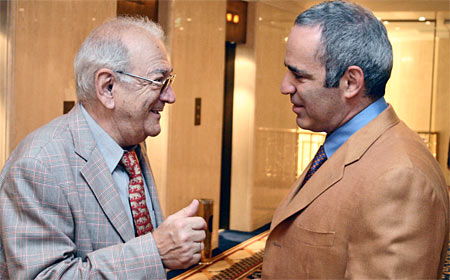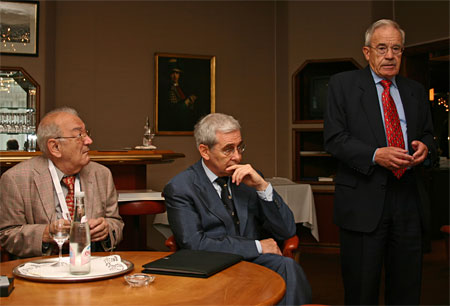FIDE's new world championship format
|
FIDE's new world championship format
Some years ago – in 1998 to be precise – FIDE started organising its world championship cycle as a 128-player knockout event (after Karpov defeated Kamsky in the last tradition FIDE challenge match 1996). Karpov was controversially seeded to the final and defeated the exhausted challenger Viswanathan Anand. After that it became a pure 128-player knockout and was won in 1999 by Alexander Khalifman, in 2000 by Viswanathan Anand, in 2002 by Ruslan Ponomariov and in 2004 by Rustam Kasimdzhanov. In 2005 FIDE changed the format to an eight-player double round robin that was won by Veselin Topalov in San Luis, Argentina. The "reunification world championship" in Elista this year pitted the FIDE champion against the break-away world champion Vladimir Kramnik, who had defeated Garry Kasparov in 2000 and defended his title against Peter Leko in 2004. Today Kramnik is the only recognised world champion in chess. The next FIDE world championship is to take place in Mexico City from September 12 to October 1st 2007 (details are available on the world championship site www.chessmexico.com). It will be an eight player double round robin in the style of the previous event in San Luis. Four players are seeded from the 2005 world championship, four more will qualify from a candidates tournament to be held in Elista next May. In the meantime the original 128-player knockout continued to be staged, as the "FIDE World Cup". The first was won by Levon Aronian in Khanty-Mansiysk, Russia (2200 km east of Moscow). Another one was agreed for the year 2007 in the same venue, in the November/December period. In a nutshell: for the future FIDE plans to keep holding the Word Cup in odd years. The winner will be the challenger and play the world champion in the next world championship match, which will be held in even years. The format of the World Cup will change, since the current format has not been accepted by top grandmasters and has also been difficult to sell to sponsors. According to the chanced scheme proposed by FIDE the 128 participants will be divided into 16 groups of eight players each, who will play round robin tournaments. The sixteen winners will play in two eight-player round robins, and the winners of these will play a four-game match against each other. The winner of the World Cup is the challenger for the world championship and play a 12-16 game match against the reigning world champion. Below is the formal proposal, presented by Berik Balgabaev, Assistant to the FIDE President. The main circumstances of the current cycle which make it “bulky” are its complicity. It is a complicated formula (for example, Candidates’ matches) that is difficult to be presented and advertised for potential sponsors. This is also one of the reasons for the top Grandmasters’ unwillingness to participate in the World Cup due to its formula. The following simple scheme is proposed: in odd years (November-December) to organize World Cup with 128 players, the winner of which will play a match of 12-16 games with the World Champion in even years. Advantages: Every year FIDE will be organizing one of the most important events (which is significant for potential sponsors and for FIDE PR activities). The FIDE shares from the prize funds of these events shall become more regular in timing. A more harmonious calendar (now: The World Cup and World Championship are organized the same year during the period September-December). The leadership and FIDE employees can concentrate on the most important event and will not be “distracted” during the preparation and organization. It is proposed to change the formula for the World Cup: Initial stage 128 players are divided into 16 groups with 8 players each on the following principle: group 1 (numbers 1, 32, 33, 64, 65, 96, 97, 128), group 2 – (2, 31, 34, 63, 66, 95, 98, 127) etc. Free days – after 4th and 7th games. Then 16 winners are divided into 2 groups with 8 players based on their rating: 1, 4, 5, 8, 9, 12, 13, 16 and 2, 3, 6, 7, 10, 11, 14, 15. Free days – after 4th and 7th games. In the final, there is a match of 4 games and possible tiebreak. Advantages: We shall not have criticisms from the participants and mass media in respect of first round: “knockout is roulette”, “lucky – unlucky”, “did not sleep well”, “one blunder and you are out” etc. The number of accidental results will fall – a total of 7 games in the first two stages is enough for the top Grandmasters to prove that they are the best. Among the 16 group winners, there will not be weaker chess players. All the games will be played with the same time control. The tie break might be necessary only in one case – if there is a tie in the final. There will be no necessity to have a large number of additional local arbiters for the tiebreaks during initial stages. Weaker participants have opportunities to meet with 7 different players from various continents, get substantial experience, and not leave after the 1st round as under the current format. The top Grandmasters will have difficulties in explaining the reason for their non-participation. No more confusion with the hotels and air-tickets, there will be a firm plan for the departures of those who are knocked out. Organisers will have more chances for the media coverage of the World Cup participants. It is easier to negotiate good prices with the hotels, as the number of the nights spent in the hotels will drastically increase. These reasons will promote the increase of the status of the event with mass media, possible organizers and sponsors and therefore, encourage the participation of all leading Grandmasters. |






























 مقاله،آموزش،خبر در زمینه شطرنج
مقاله،آموزش،خبر در زمینه شطرنج